Engineering The Dream
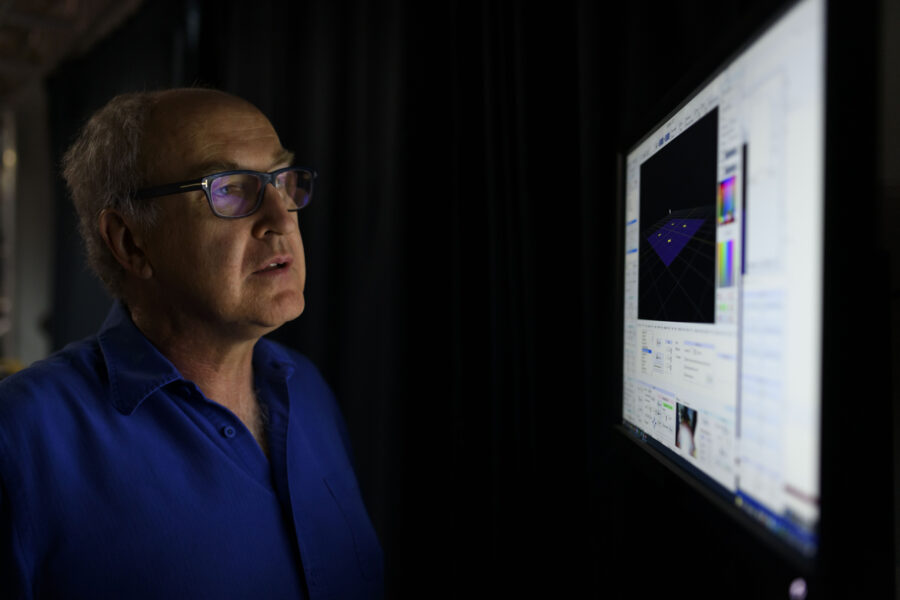
At the core of Moment Discovery’s research lies their software, Spatio. This innovative platform maps and programs spaces to respond dynamically to movement, which drives media devices. As an alternative to traditional computer setups, Spatio allows humans to move through three-dimensional spaces unencumbered by wires or wearable devices. The experiences made possible through Spatio explore responsive digital relationships, highlighting a fascinating philosophical intersection between art and science.
“Science is incredibly powerful but it is really predicated on an idea that you can carve out a variable that only changes in response to one thing. If you have variables that are not orthogonal to each other what happens? To get away from a Cartesian coordinate system you need something that allows you to navigate in a curvy way.” – Will Bauer
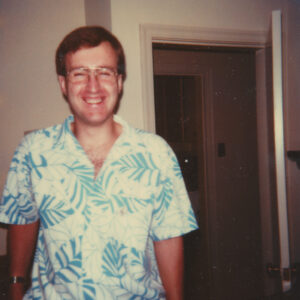
Will Bauer completed an engineering degree and worked for two years with Sherwood Park based Caulfield Engineering. Dave Caulfield, the company’s president, was talented both as a physicist and as a musician. In addition to a focus on oceanographic geophysical surveying technology R&D, Dave had done pioneering work developing computer music software, collaborating with the likes of jazz musician Tommy Banks. Inspired by this duality, Will decided to leave Caulfield to explore his already extant love of writing music, enrolling in the University of Victoria’s music composition program. Through UVic Will met a number of lifelong artistic friends and collaborators, who became strong influences. Steve Gibson, Rafael Lozano-Hemmer, Andreas Kitzmann, Nick Apivor, Glennis MacGregor were all on the scene there. Later on they were joined by Justin Love and Manjinder Benning.
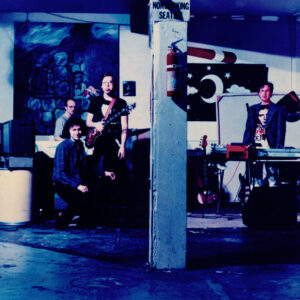
With Steve and Nick, Will formed a post-punk noise band called the Bride Stripped Bare, developing a love of performance on the stage. During this period of artistic discovery, Will began to explore ideas about alternative music composition and notation. Additionally inspired by a summer job that involved writing software for geographic contour mapping, Will developed notation which involved positioning musicians on the stage. For example, if the musician was standing at a certain position in the performance area, they were given specific instructions for how they would play their instrument. The musician’s movements would be choreographed creating a spatial composition. These ideas laid the groundwork for Will’s future software developments. After two years of schooling, Will received a call from a broadly talented engineering colleague named Dan Kenway, who invited Will to join him in a tech start-up company called Vision Smart. It was an opportunity that he could not resist and he left UVic to work in this particularly niche area of software programming. His work would involve developing real time sensing and responsive software, instructing saws to cut various patterns for lumber grading.

Two years into his work with Vision Smart, Will began reflecting more on the movement based music composition work he had started at UVic. A new conceptual path for Will took form. With support from the Canada Council for the Arts, he expanded on the composition idea, automating it by tracking the musicians ultrasonically. Through Will’s unusual pairing of art and engineering, he designed his own hardware. Gradually he put it through several years of performance tests with his art friends who he had met at school. Collectively, they were presenting large annual multimedia shows in Victoria and Montreal and by 1991 the software was able to map performance areas, creating the ability to define different types of controls in designated zones. While Will’s artistic practice was taking off, Vision Smart, the company he was still working for, had changed direction. It had become time for him to leave the company and focus on the continued development of the system he created, which he was now calling Gesture and Media System (GAMS).

In 1994 a company in Germany named Theater der Klänge (Theatre of Sound) contacted Will after reading about GAMS in a computer music journal publication. They invited him to meet them in Germany to demonstrate GAMS, and they ended up buying a system from him. Through this relationship he was introduced to an art group called Knowbotic Research from Zurich, Switzerland who were experimenting with emergent behavior of systems and virtual reality. At the time they were building wireframe VR systems. They needed a sensor for a piece they were doing called Simulation Mosaik Data Klänge (SMDK), which translates to “Simulated Mosaic of Data and Sound.” It was a virtual reality piece where the viewer walked around with a tiny monitor that showed a wireframe representation of the virtual space, which was also inhabited by sounds. As the viewer got close to the sounds, they would start playing, sometimes clumping together like binding molecules. Will became part of the team, working on this wild and beautiful piece which ended up winning an Ars Electronica Golden Nica award. Suddenly he was going off to Linz, Austria to be part of the exhibit of SMDK, which subsequently ended up touring. Through this recognition, Will was able to start selling his system to experimenters across Europe.
Throughout this period, Will continued to collaborate with his UVic friend, Rafael Lozano-Hemmer. Together they worked on elaborate, multi media installations that exhibited internationally. While living in Pasadena, Will enlisted support from a local lighting company to work on a project called The Trace. After hearing about the system Will had developed, the lighting company invited him to set one up to sell from their shop. Not long after, Will was living in Paris and received a phone call from the lighting company saying they had just had breakfast with Peter Johansen, the president of Martin Professional. Martin Professional was expressing interest in negotiating a licensing agreement and invited Will to travel to Denmark to demonstrate GAMS. They desired to use it as a lighting system that could be automated for different cues in a mapped stage responding to the performer’s movements. After meeting with Johansen, six months went by and Will never heard back from him, so he had figured the opportunity had fallen through. Having now moved back to Edmonton, Will decided to start up his own company named APR aiming to prepare his technology for manufacturing. Knowing he needed more help to reach his goals, Will hired his first employee, a computer engineer named Conroy Badger. As a welcome surprise after eleven months in business, Martin Professional finally got back to Will and ended up signing a decade-long annual licensing agreement providing Will the ability to hire a team to continue upgrading the system.
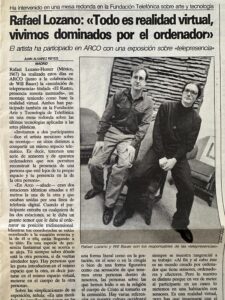
In the meantime Rafael and Will continued creating award winning artworks, which were becoming increasingly larger and more elaborate. Conroy continued to be involved, and in one circumstance he built out a series of 35 mini computer systems and stepper motor robots for an installation. Their installations involved everything from large scale projections to search lights on the tops of buildings which made 3D patterns in the sky. Notable works were included at the ARCO Contemporary Art Fair in Spain and as part of the year 2000 millennium celebrations in downtown Mexico City’s public square. It was a thrilling period being part of a relatively small international community of artists and engineers creating new media work at a time before these technologies were as easily accessible as they are now. However, Will was traveling over 5 months of the year with a young child at home and he needed to consider making some changes to his work life. By 2006 Will and Rafael decided to part ways. Will stepped away from making interactive art while raising his family, and Conroy Badger moved to Montreal to work for Rafael.
The journey back to working with human computing tech would take a few more years for Will, and a main catalyst for his return happened through meeting Pamela Anthony. In 2008 Pamela had invited Will to speak at an art and science focused symposium for the Edmonton Cultural Capital. She had initially thought she was calling someone else and mistakenly contacted Will. However, through their unexpected conversation she was excited to learn about him, as she was previously unfamiliar with his work. Will prepared a talk for the symposium entitled “The Poet’s Bandwidth,” on the topic of digital media and poetry as a form of data compression. Pamela was very intrigued by his presentation and they continued conversing about art and tech over the next few years.
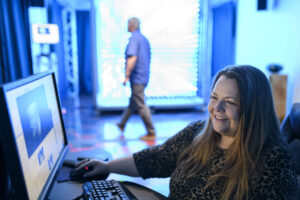
Pamela Anthony had worked as an art critic across Canada with a particular interest in dance and eventually became known for producing highly ambitious interactive media festivals such as Winter Light in Edmonton. For several years the celebrated winter festival involved multiple large scale installations concurrently activating many outdoor spaces. She eventually commissioned Will to create a couple of large scale works as part of Winter Light as well as for the University of Alberta Alumni Association’s 100th anniversary ceremonies. Will’s thirst for creating interactive media art was renewed. Pamela’s first commission of Will’s work took over Gallagher Hill in Edmonton, involving images being projected onto the ski hill. At the bottom of the hill was a lone microphone. Spectators would come and speak into the microphone and make a 4-5 line poem. As people spoke, their words would be projected and would tumble down the hill. The lines of the poetry would fall to the ground and remain there for others to see. When the speaker was finished, the poem would be read back by a computer voice uncannily engaging with the poetic phrasing in a digital representation not unlike fridge magnet poetry.
Later in 2015 Will hired Pamela to do some consulting work on interactive media for him. This led to Will asking Pamela to join the research team that he was wanting to assemble. It was unclear at first what the work would be, but Will was impressed with Pamela’s ambition. Curious about the opportunity, Pamela started working with Will on a six month contract where she helped to renovate his family home into an office, including sorting through and organizing boxes of his family history. Through coming to know Will’s childhood self, recognizing the artist in him, and realizing that they had read all the same science fiction novels, Pamela developed a sense of kinship with Will.
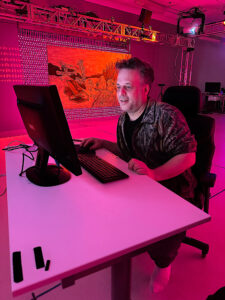
Serendipitously, Conroy Badger wrote to Will not long after. He indicated he was moving back to Edmonton, having spent the past decade touring the world with Rafael as part of his engineering team and wondered if Will knew of any work. Conroy’s return was the final push needed to bring this work back into focus. Pamela had felt she experienced so much professionally this far in her life, and had been wondering if there was anything in the cultural sector that she had not yet done. As she imagined this new path she was curious and interested to see what was possible on a science research path and continued to stay working with Will and Conroy. Together, the three began working on a full body version of GAMS which envisioned tagless tracking, ultimately leading to Moment Discovery’s incorporation in 2017. In Will’s words, “The diverse perspective that Pamela brought completely changed the evolutionary path of the company in terms of what was prioritized and what goals were in place, not only regarding software capabilities, but also in terms of people.”
Throughout Pamela’s journey in the company she was most captivated by the making of things. She wanted to get good enough at the technology to create and break rules of her own. Conroy and Will were very supportive of her learning. Will could see that her concepts were unconventional and found this to be inspirational both for himself and for others. For example, the soundtrack she made called Distracted Circus was one of his very favorite of all time interactive sound pieces. He said, “It was strangely glitchy and wonderful, coming from someone who was not a trained musician, conjuring surreal images of a distorted circus.” Through Pamela’s ability to build community she has been a huge part of what Moment Discovery is, bringing all kinds of perspectives to the company, including a feminist perspective. Importantly, this perspective has illuminated how the world is experienced by women for Will and Conroy. Eventually, Pamela suggested the team build DotBox, a large cube containing rows of RGB light bulbs; so that a physical representation of the 3D software could be demonstrated. Pamela and Conroy set to work on building the DotBox in her studio on Jasper Avenue. Pamela speaks fondly of this concentrated time spent together, as she found Conroy to be a beautiful creator and a really responsive collaborator. Since building DotBox the team has presented multiple shows with audiences, and invited more artists to create on DotBox. More recently the team has built a DotWall and sound related work including experiments in modern day voice recognition technology, imagining more ways of using the software to create artistically.
Putting tools in the hands of other people has greatly informed their technology. Artists have been involved from the very beginning. Working with Amber Borotsik and Kristi Hansen in the early years of Moment Discovery, they witnessed the truth that bodies moving in real time was central to their capacity to represent something within the technology. Connecting all the way back to the trackers in Will’s earlier work, the expression of movement influences the response from the machine. Today Moment Discovery continues to collaborate with artists to advance and expand the uses for their technology seeking to solve the questions that they find intriguing in the realm of human computing.
Written by Kelly Ruth